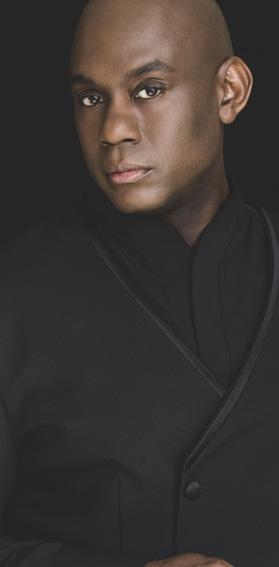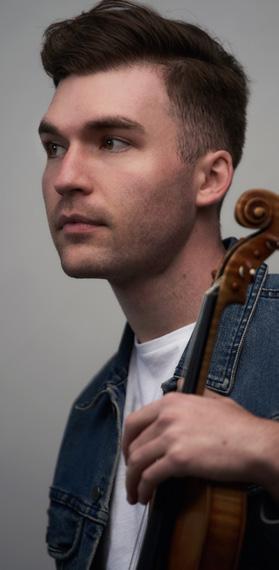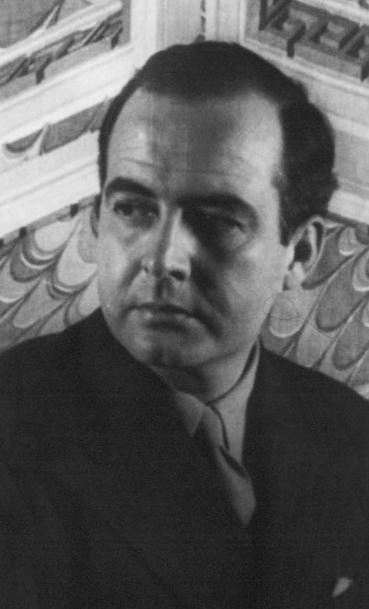
10 minute read
DVOŘÁK'S NEW WORLD SYMPHONY
Friday, May 10, 2024 at 11:15 am
Saturday, May 11, 2024 at 7:30 pm
ALLEN-BRADLEY HALL
Joseph Young, conductor
Alexi Kenney, violin
PROGRAM
BRIAN RAPHAEL NABORS
Pulse for full orchestra
SAMUEL BARBER
Concerto for Violin and Orchestra, Opus 14
I. Allegro
II. Andante
III. Presto in moto perpetuo
Alexi Kenney, violin
INTERMISSION
ANTONÍN DVOŘÁK
Symphony No. 9 in E minor, Opus 95, B. 178, “From the New World”
I. Adagio - Allegro molto
II. Largo
III. Scherzo: Molto vivace
IV. Finale: Allegro con fuoco
The 2023.24 Classics Series is presented by the UNITED PERFORMING ARTS FUND and ROCKWELL AUTOMATION
The length of this concert is approximately 1 hour and 45 minutes.
Guest Artist Biographies
JOSEPH YOUNG

Joseph Young balances a flourishing guest conducting career with leadership roles as music director of the Berkeley Symphony and artistic director of ensembles at the Peabody Conservatory.
“Joseph Young has had quite a year…impressive,” wrote Washington Classical Review of his 2023 National Symphony Orchestra debut, which capped a year of debuts that included leading Jeanine Tesori’s Blue with Washington National Opera, the LA Phil at the Hollywood Bowl, and NYO2 at Carnegie Hall and on tour in the Dominican Republic, as well as collaborations with composer Du Yun, pianist Lara Downes, artist William Kentridge, bass-baritone Davóne Tines, and icon Debbie Allen.
Other recent and upcoming guest engagements include the San Francisco Symphony, Seattle Symphony, New Jersey Symphony, Milwaukee Symphony, Detroit Symphony, New World Symphony Orchestra, Spoleto Festival Orchestra, Orquestra Sinfónica do Porto Casa da Música (Portugal), the Orquesta Sinfónica y Coro de RTVE (Spain), and the Mzansi National Philharmonic Orchestra (South Africa). In July 2024, he will conduct the Cincinnati Symphony Orchestra in the Cincinnati Opera’s world premiere staging of the Liverpool Oratorio, Paul McCartney’s acclaimed 1991 work for orchestra, chorus, and soloists.
Earlier in his career, Young served as the assistant conductor of the Atlanta Symphony, music director of the Atlanta Symphony Youth Orchestra, and resident conductor of the Phoenix Symphony. He also served as the League of American Orchestras Conducting Fellow at the Buffalo Philharmonic and Baltimore Symphony Orchestra. Young holds an Artist Diploma from the Peabody Conservatory, studying with Gustav Meier and Markand Thakar. His mentors include Jorma Panula, Robert Spano, and Marin Alsop, with whom he maintains an artistic partnership. Now a mentor himself, Young shapes the future of classical music through his dynamic engagements with major symphony orchestras, his steadfast commitment to teaching in classrooms and concert halls, and his service on the board of New Music USA.
ALEXI KENNEY

Violinist Alexi Kenney is forging a career that defies categorization, following his interests, intuition, and heart. He is equally at home creating experimental programs and commissioning new works, soloing with major orchestras around the world, and collaborating with some of the most celebrated musicians of our time. Kenney is the recipient of an Avery Fisher Career Grant and a Borletti-Buitoni Trust Award.
Highlights of Kenney’s 2023.24 season include appearing as soloist with the Dallas, Pittsburgh, and Milwaukee symphonies, leading a program of his own creation with the New Century Chamber Orchestra, and debuting a new iteration of his project Shifting Ground at the Baryshnikov Arts Center and the Ojai Festival in collaboration with the new media and video artist Xuan. Shifting Ground intersperses seminal works for solo violin by J.S. Bach with pieces by Matthew Burtner, Mario Davidovsky, Nicola Matteis, Kaija Saariaho, Paul Wiancko, and Du Yun, as well as new commissions by composers Salina Fisher and Angélica Negrón.
In recent seasons, Kenney has soloed with the Cleveland Orchestra, San Francisco Symphony, l’Orchestre de la Suisse Romande, Detroit Symphony, Rochester Philharmonic, Indianapolis Symphony, Gulbenkian Orchestra, St. Paul Chamber Orchestra, Oregon Symphony, Louisville Orchestra, and l’Orchestre de Chambre de Lausanne, as well as in a play-conduct role as guest leader of the Mahler Chamber Orchestra. He has played recitals at Wigmore Hall, on Carnegie Hall’s “Distinctive Debuts” series, Lincoln Center’s Mostly Mozart Festival, Philadelphia Chamber Music Society, 92nd Street Y, Mecklenberg-Vorpommern Festival, and the Isabella Stewart Gardner Museum. Winner of the 2013 Concert Artists Guild Competition and laureate of the 2012 Menuhin Competition, Kenney has been profiled by Musical America, Strings Magazine, and The New York Times, and has written for The Strad.
Program notes by Elaine Schmidt

BRIAN RAPHAEL NABORS
Born 10 April 1991; Birmingham, Alabama
Pulse for full orchestra
Composed: 2019
First performance: 9 September 2019; Giancarlo Guerrero, conductor; Nashville Symphony Orchestra
Last MSO performance: MSO Premiere
Instrumentation: 3 flutes (3rd doubling on piccolo); 2 oboes; English horn; 3 clarinets (3rd doubling on bass clarinet); 2 bassoons; contrabassoon; 4 horns; 3 trumpets; 2 trombones; bass trombone; tuba; timpani; percussion (bass drum, bongo drums, crotales, high hat, marimba, suspended cymbals, tam-tam, tom-tom, triangle, vibraphone, whip, wood block, xylophone); harp; piano (doubling on celeste); strings
Approximate duration: 12 minutes
Born in Birmingham, Alabama, Brian Raphael Nabors grew up with parents who were quite active in the arts. His mother was a local keyboard player and his father was a visual artist. Nabors was interested in music from a young age, but contemplated architecture as a career. He was self-taught as a pianist until he was about 12, absorbing the music he heard around him, which included R&B, jazz, and gospel. Film scores introduced him to the expressive world of orchestral music. He began composing as a teenager and began to realize that he needed to become a composer.
Alongside his compositional work, Nabors remains an active pianist today. He has a form of synesthesia, which manifests as an ability to see harmonies, rather than pitches, as colors. Nabors wrote Pulse in 2017 as a piece for chamber orchestra. He expanded it for full orchestra in 2019, writing about the piece, “My conception of Pulse began as a long contemplation of daily life as we know it, combined with thoughts of life in nature. The universe seems to have this natural rhythm to it. It is as if every living and moving thing we are aware and unaware of is being held together by a mysterious, resolute force. Pulse is an episodic rhapsody that explores several phases and colorful variants of rhythm, all held together by an unwavering pulse. Each episode is meant to symbolize a different scenario of life for the listener, be it a buzzing, modern metropolis, a deep wilderness abundant with animalia, or the scenic, endless abyss of the ocean. All of these worlds and their philosophical meanings are then brought together in a contemplative theme of ‘unification’ in the strings that symbolizes our deep connection as living beings to everything within, over, under, and around us.”

SAMUEL BARBER
Born 9 March 1910; West Chester, Pennsylvania
Died 23 January 1981; New York City, New York
Concerto for Violin and Orchestra, Opus 14
Composed: 1939
First performance: 7 February 1941; Eugene Ormandy, conductor; Albert Spalding, violin; Philadelphia Orchestra
Last MSO performance: 17 June 2017; Yaniv Dinur, conductor; Ilana Setapen, violin
Instrumentation: 2 flutes (2nd doubling on piccolo); 2 oboes; 2 clarinets; 2 bassoons; 2 horns; 2 trumpets; timpani; percussion (snare drum); piano; strings
Approximate duration: 25 minutes
American composer Samuel Barber was one of the most respected composers of the 20th century. Barber was unique among American composers of his time in that he was able to make his living entirely as a composer. He was also unique among American composers of his time in that he strongly favored tonal, expressive writing over atonality, or any other fashionable compositional devices of his era.
While we’re looking at ways in which Barber was unique, let’s add his violin concerto and its decades-long story to the list. Barber received a commission to write the concerto in 1939 for Russian-born American violinist Iso (pronounced EE-so) Briselli to premiere. Briselli and Barber had been part of the first graduating class of the Curtis Institute of Music in Philadelphia, where they had become friends. When Barber sent the first two movements to Briselli, the violinist liked them a great deal. But when he saw the third movement, a four-minute spate of perpetual motion for the solo violin, along with quite virtuosic writing for the orchestra, set in a key completely unrelated to the first two movements of the piece, Briselli, or perhaps his rather controlling coach in New York City, felt the short movement lacked sufficient substance. Briselli expressed this concern to Barber, who was not inclined to change it. They decided, mutually, to drop the project. The two remained good friends until Barber’s death in 1981, both enjoying successful careers. Story over, yes?
No. Shortly after they dropped the project, a rumor began swirling around the violin world about Briselli rejecting the concerto because the final movement was too difficult for him to play. It was utterly false, but it was repeated among violinists for decades, until research at the end of the 20th century, and subsequent articles, finally put it to rest.

ANTONÍN DVOŘÁK
Born 8 September 1841; Nelahozeves, Austrian Empire (now the Czech Republic)
Died 1 May 1904; Prague, Austrian Empire (now the Czech Republic)
Symphony No. 9 in E minor, Opus 95, B. 178, “From the New World”
Composed: 10 January – 24 May 1893
First performance: 16 December 1893; Anton Seidl, conductor; New York Philharmonic Society
Last MSO performance: 28 April 2018; Hans Graf, conductor
Instrumentation: 2 flutes (2nd doubling on piccolo); 2 oboes (2nd doubling on English horn); 2 clarinets; 2 bassoons; 4 horns; 2 trumpets; 3 trombones; tuba; timpani; percussion (cymbals, triangle); strings
Approximate duration: 40 minutes
By 1890, Czech composer Antonín Dvořák was regarded as second only to Johannes Brahms among living composers. He and his music were in demand across Europe and even across the pond in the United States. When the leaders of the National Conservatory of Music in New York City (founded in 1885) offered Dvořák a position paying him about 25 times what he was making at the Prague Conservatory and requiring just three hours of work per day and summers off, he could not refuse. Why such a sweet deal? Dvořák explained in a letter to a colleague in Europe, “The Americans expect great things of me. I am to show them the way to the Promised Land, the realm of a new, independent art, in short, a national style of music.” The work schedule was to leave him plenty of time to compose.
Once he was in the U.S., Dvořák researched American folk music and Native American music, incorporating elements of both in his Symphony No. 9 (“From the “New World”) so successfully that musicologists spent decades looking for the tunes they were sure he had simply quoted. They found nothing. It was all his original music. His “New World” Symphony and several other of his American compositions remain among his best-known and best-loved pieces today, including the String Quartet No. 12 in F major (the “American” quartet) and the Cello Concerto. Dvořák’s combined skills as a melodist, harmonist, and orchestrator, combined with his time in New York and in the Czech town of Spillville, Iowa, allowed him to create a uniquely vivid musical image of America, capturing such elements as the brash, bold character of New York, the sweeping landscape he encountered in Iowa, and the yearning homesickness he shared with countless immigrants. Dvořák originally called the symphony “Impressions and Greetings from the New World.”

